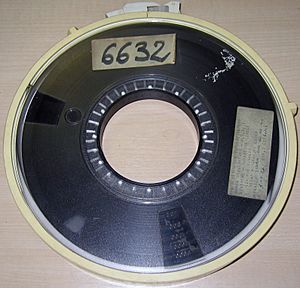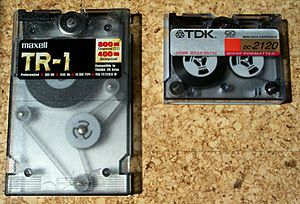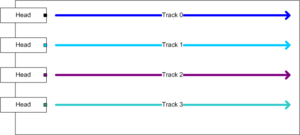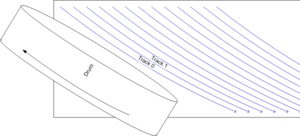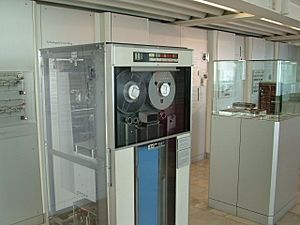Magnetic-tape data storage facts for kids
Magnetic tape storage is a way to save digital information on a special kind of tape. This tape uses magnetism to record and keep data.
In the early days of computers, tape was super important. It was used to store a lot of main computer data. These tapes often came on big open reels. Today, magnetic tape usually comes in small cases called cartridges or cassettes. Examples include Linear Tape-Open (LTO) and IBM 3592 tapes.
The machine that writes or reads data from the tape is called a tape drive. Sometimes, robots called autoloaders or tape libraries are used. They help handle and swap out tape cartridges automatically.
Today, tape storage is mostly used for backing up computer systems. It's also great for keeping old data safe for a long time. Because tape is cheap, it's still a good choice for long-term storage and archiving.
Contents
Old-Style Tapes: Open Reels
At first, magnetic tape for computers came on large 10.5-inch (27 cm) reels. This was the standard for big computer systems until the late 1980s. Over time, these tapes could hold more and more data. This was because the tape material got thinner and the way data was saved improved.
Smaller tape cartridges and cassettes started appearing in the mid-1970s. These were often used with smaller computer systems. In 1984, IBM introduced the 3480 cartridge. It was much smaller but held more data. This made big computer systems start using cartridges instead of open reels.
UNIVAC: The First Computer Tapes
Magnetic tape was first used to record computer data in 1951. This happened on the UNIVAC I computer. The tape was a thin metal strip, about 0.5-inch (12.7 mm) wide. It was made of nickel-plated phosphor bronze.
Data was saved very closely together. There were 128 characters per inch on eight tracks. Six tracks held the actual data. One track checked for errors (called parity). The last track was for timing. The tape moved at 100 in/s (2.54 m/s). This allowed it to transfer 12,800 characters per second.
IBM Tape Formats
IBM computers from the 1950s used tape coated with ferric-oxide. This was similar to the tape used for music. IBM's way of doing things quickly became the standard for the whole industry.
Magnetic tapes were 0.5-inch (12.7 mm) wide. They came on reels that could be removed. Common tape lengths were 1,200 feet (370 m) and 2,400 feet (730 m). In the 1980s, even longer tapes like 3,600 feet (1,100 m) became available. These used a much thinner plastic film. Most tape drives could handle reels up to 10.5 inches (267 mm).
Smaller reels, called mini-reels, were used for smaller amounts of data. These were 7-inch (18 cm) reels. Their length often varied to fit the data, which saved money.
Early IBM tape drives, like the IBM 727, were very complex machines. They stood on the floor and used special "vacuum columns." These columns helped the tape start and stop very quickly. When working, the tape reels would spin in fast, jerky bursts. This made them look very exciting in movies and TV shows.
Old half-inch tapes had seven parallel tracks for data. This allowed 6-bit characters plus 1 parity bit. This was called 7-track tape. Later, with the IBM System/360 computer, 9-track tapes were made. These supported the new 8-bit characters.
The end of a file on tape was marked by a special pattern called a tape mark. Two tape marks in a row meant the end of all recorded data. Reflective strips of foil showed the physical start and end of the usable tape.
Over time, more data could be packed onto the tape. Seven-track tapes started at 200 characters per inch (CPI). Then they went to 556, and finally 800 CPI. Nine-track tapes had densities of 800, then 1600, and finally 6250 CPI. This meant a standard 2,400 ft, 730 m reel could hold about 5 to 140 megabytes.
Nine-track tapes became very popular in the 1970s and 1980s. This was partly because of the success of the System/360. IBM stopped making new reel-to-reel products in 1984. They switched to cartridge-based products, starting with the 3480 family.
DEC Tape Format
LINCtape and DECtape were different types of "round tape." They were like personal storage for computers. They used 0.75 inches (19 mm) wide tape. They had a special track that allowed data blocks to be read and rewritten in the same spot. This was different from standard tape.
LINCtapes and DECtapes held similar amounts of data as diskettes. But it took much longer to find data on them, sometimes thirty seconds to a minute.
Modern Tapes: Cartridges and Cassettes
When we talk about tape cassettes or cartridges, we mean a length of magnetic tape inside a plastic case. This case has one or two reels to control the tape's movement. The way the tape is packaged affects how fast it can be loaded and unloaded. It also affects how much tape it can hold.
In a single-reel cartridge, the tape drive has one reel to pull the tape. A dual-reel cartridge has both reels inside the cartridge itself. A tape drive uses motors to wind the tape from one reel to the other. As it moves, the tape passes a read/write head.
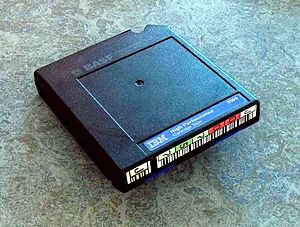
Another type is the endless tape cartridge. This has a continuous loop of tape. The tape comes out from the center of the reel and wraps around the edge. This means it doesn't need to rewind to repeat.
In 1961, IBM introduced the 7340 Hypertape drive. It used a dual-reel cassette with 1-inch-wide (2.5 cm) tape. Each cassette could hold 2 million 6-bit characters.
In the 1970s and 1980s, regular audio Compact Cassettes were often used. They were a cheap way to store data for home computers.
In 1984, IBM launched the 3480 family of single-reel cartridges. These were made by many companies for years. They started by holding 200 megabytes per cartridge. Over time, their capacity grew to 2.4 gigabytes. DLT was another cartridge tape available from 1984. However, its development stopped in 2007 in favor of LTO.
In 2003, IBM introduced the 3592 family. These tapes are not compatible with the older 3590 series. Like the 3590 and 3480, these use 1⁄2-inch (13 mm) tape in a single-reel cartridge. The first ones held 300 gigabytes. By 2018, the sixth generation could hold 20 terabytes!
Linear Tape-Open (LTO) cartridges were first announced in 1997. They started at 100 megabytes. The eighth generation now holds 12 terabytes in the same size cartridge. As of 2019, LTO has become the most common tape technology for computers.
How Tape Works: Technical Details
Data Density
Bytes per inch (BPI) tells us how much data is packed onto magnetic tape. It usually means how many bytes are stored per inch. Sometimes, it can mean "bits per inch."
Tape Width
The width of the tape is a main way to sort tape technologies. One-half-inch (13 mm) tape has been the most common for storing large amounts of data. Many other sizes exist. They were made to be smaller or hold more data.
Recording Methods
The way data is recorded on tape is also important. There are two main types: linear and scanning.
Linear Recording
The linear method puts data in long, parallel tracks along the tape's length. Several tape heads write tracks at the same time. This was used in early tape drives. It's simple but stores the least amount of data.
A newer linear method is called linear serpentine recording. It uses more tracks than tape heads. Each head writes one track at a time. After going across the tape, the heads shift. Then they write another set of tracks in the opposite direction. This repeats until all tracks are used. This method allows much more data to be stored on the same length of tape.
Scanning Recording
Scanning recording methods write short, dense tracks across the tape's width. The tape heads are on a spinning drum or disk. This drum spins fast while the tape moves slowly past it.
One early scanning method was "transverse scan." Here, a spinning disk with tape heads was placed sideways to the tape. Another early method was "arcuate scan." The heads were on a flat spinning disk against the tape. The path of the heads made an arc.
Helical scan recording writes short, dense tracks in a diagonal way. This method is used by almost all modern videotape systems. It's also used in several data tape formats.
Data Blocks and Speed Matching
Data is written to tape in chunks called "blocks." There are small gaps between these blocks. Each block is written in one go, with the tape moving constantly.
However, computers don't always send data at the same speed the tape drive needs. If the computer is too slow, the tape drive might stop, back up, and restart. This is called "shoe-shining."
Modern tape drives use a "speed matching" feature. The drive can slow down the tape's physical speed. This helps avoid "shoe-shining" and keeps the data flowing smoothly.
Finding Data: Sequential Access
Tape storage is known for sequential access. This means you have to go through the tape in order to find data. It can take tens of seconds to load a tape and find the right spot. Think of it like finding a song on an old cassette tape. You have to fast-forward or rewind.
In contrast, a hard disk can find data in milliseconds. This is like finding a song on a digital music player instantly. Hard disks offer random access to data.
Because of this, most tape systems use a simpler way to organize files. Files are often found by a number, not a name. Tools like file archivers and backup programs pack many files into one tape file. This helps keep things organized.
The Linear Tape File System is a newer way to store file information. It puts file names and details on a separate part of the tape. This lets you copy and paste files to a tape like it's a disk. But the tape still works by finding data in order.
Access Time
Tape has a long "random access time." This is because the tape drive often has to wind through about one-third of the tape to get from one spot to another. Tape systems try to make this faster. They might use an index, which is a separate list that tells where data blocks are on the tape.
Data Compression
Most tape drives now include lossless data compression. This means they can make data smaller without losing any information. This helps fit more data on each tape. A common compression ratio is 2:1. This means the data takes up half the space.
However, the actual amount of compression depends on the data. For example, text files or raw images usually compress very well. But data that is already compressed (like JPEG images or MP3 music) or encrypted data usually cannot be compressed further. Sometimes, they might even get slightly larger.
Encryption
There are ways to encrypt tapes. Encryption scrambles the data so that only people with the right key can read it. This is important for security. If a tape is lost or stolen, the data stays safe. Some advanced tape drives have special hardware to encrypt data quickly.
Smart Cartridges: Memory and Barcodes
Some tape cartridges, like LTO cartridges, have small computer chips built into them. These chips store information about the tape. This includes the type of tape, its storage size, and dates. Tape cartridges also often have barcodes on their labels. These barcodes help automated tape libraries find and manage the tapes.
Why Tape is Still Used Today
Tape is still important in modern data centers for a few reasons:
- It's the cheapest way to store huge amounts of data.
- Since tapes can be removed, they create an "air gap." This means the data is physically disconnected from the network. This protects it from hackers, viruses, or accidental deletion.
- Tapes last a very long time. This is important for keeping data that needs to be saved for many years, sometimes by law.
Even the cheapest cloud storage services can use tape behind the scenes.
Super High-Density Tapes
Companies are always working to make tapes hold even more data. In 2014, Sony and IBM announced a breakthrough. They could record 148 gigabits per square inch on tape. This could allow a single tape to hold 185 terabytes! Sony later improved this in 2017, reaching 201 gigabits per square inch. This could mean a tape capacity of 330 terabytes.
In 2014, Fujifilm also announced a new technology. They plan to develop a 154 terabyte tape cartridge with IBM. This tape uses a special material called NANOCUBIC. It helps pack more data onto the tape.
In 2020, Fujifilm and IBM announced technology that could lead to a tape holding 580 terabytes! They are using a new recording material called strontium ferrite.
Timeline of Tape Formats
|
See also
 In Spanish: Cinta magnética de almacenamiento de datos para niños
In Spanish: Cinta magnética de almacenamiento de datos para niños
- Computer data storage
- Magnetic storage
- Tape drive
- Information repository
- Data proliferation
- Tape mark
- Linear Tape-Open


